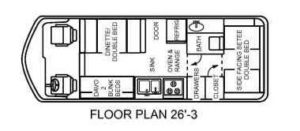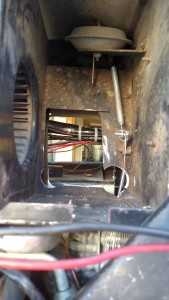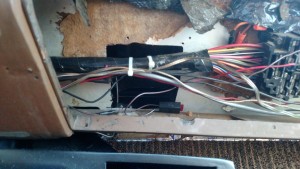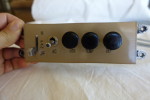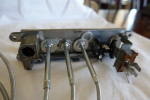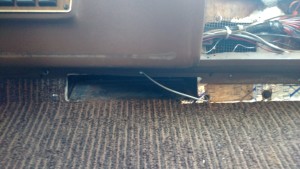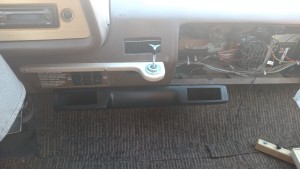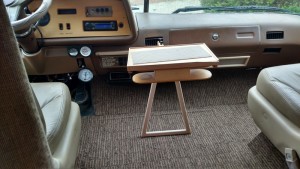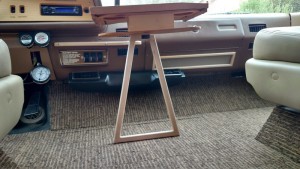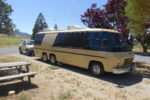
FOR SALE SOLD: Restored and Modernized – a 1976 GMC Eleganza. It’s a beauty. Updated and modernized in every way. She (Barbie) was quite spoiled and has every bell and whistle we could afford in the last 11 years – everything from a FiTech fuel injection system to a drinking water dispensing system. Her interior is modern and clean – best floor plan ever, with long twin beds in front and a fabulous dinette in the back, all new maple custom cabinets, new flooring, new ceiling…..must see!!! HERE is a walk-around video I made to help.
Please note: this coach was an Eleganza II when we got it but it is now something a little different. Instead of maximizing the number of sleeping spaces we have opted to make it perfect for a couple. It now has twin beds in the front living space and a customized dinette in the back, taking advantage of the largest window in the coach. It is very comfortable for sleeping and the dinette is amazing – comfort with a view.
We are asking $29,500 for the coach – including miscellaneous spare GMC parts and manuals.
Below is a list of specific areas of the GMC and some improvements and changes that we have made in each of the areas. Depending on the area, there are links from our web site on some items and photo after each section if available.
Safety and braking have always been top concerns for us so we have done the following:
- Applied GMC reaction arm 4-wheel disc braking on rear (no parking brake)
- 80mm brake calipers on front wheels
- Dave Lenzi sensitized brake booster
- 100% Duty cycle high capacity auxiliary vacuum pump for brakes
- Aqueous foam fire suppression system in engine compartment
- Halon fire extinguisher in refrigerator compartment
Driving comfort improvements:
- Rostra electronic cruise control
- Dash A/C modified/fixed – works great
- Ventilation ports in cab floor
- Both windshields replaced in last 8 years
- Lumina wipers and blades
- Drives and steers like a car – no wandering
- Ramco remote control mirrors
- Added lights and gauges: low fuel pressure light, voltage, engine vacuum, engine and transmission temperature
The drive train and suspension are in great shape:
- Low mileage replacement 455 engine from Calif. government-maintained coach – better than rebuilt (52,000-mile engine installed at 168,200 – now 172,000 so 56,000 miles on engine)
- 3.55 final drive
- Transmission rebuilt in 2012 (about 40K miles ago)
- JR Slaten SS engine oil cooler lines
- New starter
- Fuel hoses replaced 2007
- Dual SS Magnaflow mufflers
- KYB shocks (old but still good)
- OEM knuckles have zerk fittings for easier maintenance
- Applied GMC Quad-bag rear suspension with VIAIR 480C compressor and SS tank
- Tires replaced in 10/2014 with BF Goodrich Commercial T/A’s
Most GMCs and Barbie included have issues with hot weather. Every year when Summer approaches the discussions on the GMCnet (and now Facebook) migrate toward fan clutches, temperature gauges, fuel vapor issues (“vapor lock”) and overheating concerns. Living in Southern Arizona and its Summer temperatures of 110°F to 120°F exaggerates these issues so we have done lots to address them and they are now gone:
- Aluminum radiator
- Radiator baffles and spoiler direct air through radiator
- Never any fan noise with medium-duty fan clutch
- Fuel tanks insulated with ceramic fiber blanket insulation and covered with tin
- Electric fuel pump – no mechanical
- FiTech EFI system with FCC – Paterson carburetor is backup
- exhaust crossover ports blocked
Onan 6K generator works great
- Onan carb rebuilt
- pertronix ignition (on flywheel)
- upgraded control board
- new mount cushions
- new muffler
- Genturi exhaust for Onan
House systems:
- Dometic RM2652 2-door refrigerator (120V + propane 1998)
- Macerator
- New SS water heater
- Intellipower PD9245CV power converter
- Surge tank and whisper-king water pump in house water system
- Dual water pump switchs with indicator lights
- New Suburban 19K BTU furnace in 2014
- Tri-metric battery meter
- 140 Watt solar panel and charge controller
- House and chassis battery shutoff switches (Blue Sea)
- Thermostatic mixing valve in bathroom (no burns)
Exterior appearance:
- Exterior painted in 2014 (base/clear two tone paint)
- Second generation windows tinted and rebuilt 4 years ago
- Eagle 16” wheels (non-hub-centered)
- Through-bumper trailer hitch
Interior updates and upgrades:









